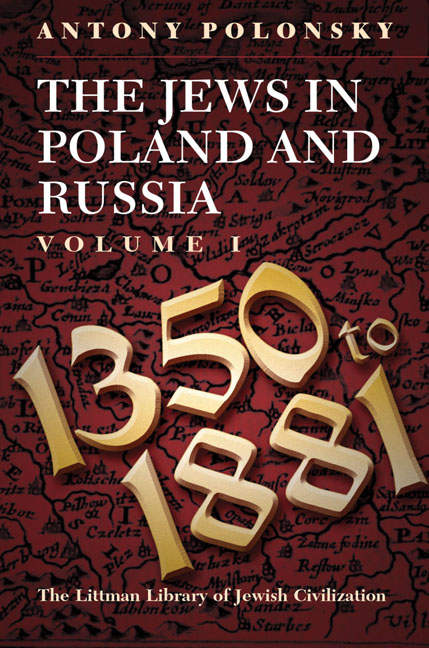Book contents
- Frontmatter
- Dedication
- Acknowledgements
- Contents
- List of Maps
- List of Tables
- Note on Transliteration
- Note on Place Names
- Maps
- General Introduction
- PART I JEWISH LIFE IN POLAND–LITHUANIA TO 1750
- PART II ATTEMPTS TO TRANSFORM AND INTEGRATE THE JEWS, AND THE JEWISH RESPONSE, 1750–1880
- Glossary
- Bibliography
- Index
9 - The Jews in the Duchy of Warsaw and the Kingdom of Poland, 1807–1881
- Frontmatter
- Dedication
- Acknowledgements
- Contents
- List of Maps
- List of Tables
- Note on Transliteration
- Note on Place Names
- Maps
- General Introduction
- PART I JEWISH LIFE IN POLAND–LITHUANIA TO 1750
- PART II ATTEMPTS TO TRANSFORM AND INTEGRATE THE JEWS, AND THE JEWISH RESPONSE, 1750–1880
- Glossary
- Bibliography
- Index
Summary
AS A RESULT of the three partitions of Poland at the end of the eighteenth century, and particularly as a consequence of the redrawing of the Polish boundaries at the Congress of Vienna in 1814–15, the tsarist empire absorbed within its borders the larger part of the Polish lands. The Russian partition was qualitatively different from the areas ruled by Prussia and Austria. It was here that the fate of Poland was decided, it was here that the principal political struggles took place, and it was here that the potential future capital of an independent Poland, Warsaw, was located.
As a result of these territorial changes the tsarist empire now contained the largest Jewish community in the world. Thus, in 1820 Jews made up 1.6 million of the empire's population of 46 million. The number of Jews rose rapidly in the nineteenth century, reaching 4 million in 1880 (out of 86 million) and 5.6 million in 1910 (of 130.8 million). This community was largely inherited from the Polish–Lithuanian Commonwealth, but it lived in two very different environments. The smaller part of the community (400,000 in 1820, 1.1 million in 1880) lived in the Kingdom of Poland (see Map 7). This was an autonomous, semiconstitutional state created at the Congress of Vienna to satisfy, at least in part, the national aspirations of the Poles. It was in dynastic union with the Romanovs and its autonomous status was severely restricted after the unsuccessful Polish uprising of 1830–1, and almost entirely done away with in the aftermath of that of 1863–4. It did, however, possess a constitution and a concept of citizenship, which meant that, in theory at least, there was a basis for the transformation of the Jews into citizens. The remainder of the Jews found themselves in the western part of the autocratic tsarist monarchy (the Pale of Settlement). This had only a weak and undeveloped version of the estate structure which had developed in Western Christendom during the Middle Ages, and was still essentially an autocracy of a patriarchal kind. It lacked any concept of citizenship.
The situation of the Jews developed very differently in the two areas.
- Type
- Chapter
- Information
- The Jews in Poland and RussiaVolume I: 1350 to 1881, pp. 273 - 321Publisher: Liverpool University PressPrint publication year: 2009

